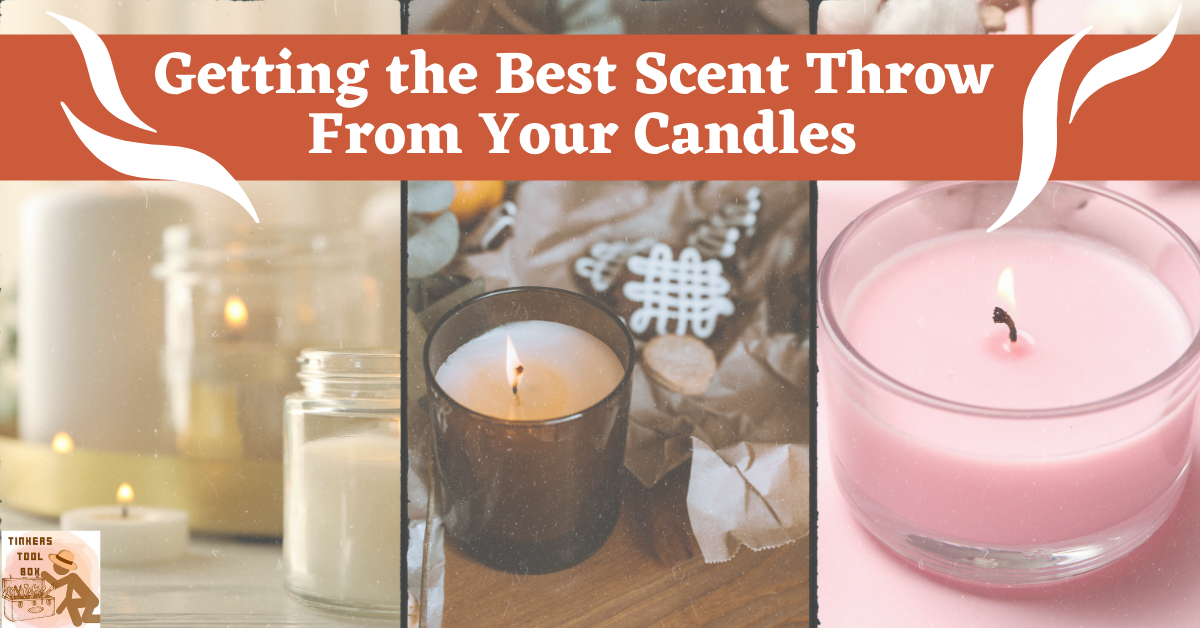One of the tricky parts in candle making is ensuring that your scented candles smell the way you wanted them, using the right amount of fragrance or essential oils. However, just incorporating the appropriate amount would not produce perfect-smelling candles, as temperatures, curing time, and personal preference also influences the scent of your candle.
Get the best scent throw from your candles by choosing the right type of wax that holds the most fragrance. You need to ensure the fragrances are incorporated at the correct temperature, and the candle would have the proper curing time and storage to preserve the scents when the candle is unlit.
This article talks about the practices a candle maker can do to ensure the best scent throw for their candles. We will tackle the specifics of ensuring that both hot and cold throws are covered and the candle smells the way you want to by following these important steps. We also include some tips and tricks you can do to make sure that all fragrances incorporated into candles will not go to waste, and you’ll get the product you spend your money on.
- Things to Remember to Get the Most Scent Throw in Candles
- Wax Type That Has the Most Fragrance Hold
- Pair the Wax with Additives for Higher Fragrance Load
- Using an Appropriate Amount of Fragrances is a Must
- Proper Wick Type and Size
- Go for Fragrances Having Strong Fragrance Notes
- Avoid Too Much Candle Colorants
- Following the Correct Temperature When Pouring Your Scents
- Enough Curing Time Makes a Big Difference
- Light the Candle in a Space Appropriate for Its Size
- Proper Storage of Scented Candles
- Factors Affecting Scent Throw
- Conclusion
Things to Remember to Get the Most Scent Throw in Candles
There are many elements to scent throw that every candle maker should master to produce well-burning and fragrant scented candles. These steps in candle making are crucial parts that you cannot skip to perfect your candles and should be taken in detail and with precaution. Here are the things you need to keep in mind in making candles with the best scent throw.
Wax Type That Has the Most Fragrance Hold
Candle waxes have varying fragrance holds, which react differently when incorporated with fragrances. Even the most high-quality fragrances would still not give the best scent throw for your candles. It is best to do continuous trial and error to achieve the scent that fits your preference.
As a general rule, paraffin wax holds the top spot for giving the best scent throw to candles. The wax is known to easily accept and blend with scents and colorants, making them the perfect choice for scented candles.
The low melting point wax helps retain scents throughout the candles and slowly releases them into the air. This makes the candle have a strong cold throw (scent when not lit) and a hot throw (scent when the candle is burning). You may want to avoid candle waxes that are picky with scents like soy wax.
Pair the Wax with Additives for Higher Fragrance Load
Candle makers could also resort to enhancers or additives that help retain more fragrances in your candles. Many waxes in the market are blended with scent enhancers to ensure that the scented candle lasts long.
Some of the known and proven additives you may want to try are vybar, Crisco shortening, and polysorbate 80. Vybar aids in fragrance oil retention, enhances candle colors, and increases candle opacity.
If you use essential oils on paraffin wax, you can add polysorbate 80, a non-synthetic and nonionic surfactant. It helps prevent essential oils from pooling at the bottom of the candle container by helping it mix well with the wax.
Crisco shortening is another great additive to pair with paraffin wax. Mix one to two ounces of this per pound of paraffin for a better scent throw. The shortening is best used on container candles and the scented ones.
Using an Appropriate Amount of Fragrances is a Must
I cannot stress enough how important it is always to follow the right amount of fragrances for candles. As you want a stronger scent throw, you might think that putting more scents would be the solution, but it may be another reason for a weaker scent throw.
The tricky part about scented candles is that putting too much or too little fragrances would result in a weak scent throw. You should bear in mind that not all waxes have the same fragrance loads and should also consider the flashpoint of the scent. Moreover, some scents are created strong, and some are subtle, and your preference would play a big part in your candle’s end scent.
Candle waxes can only hold 10-12 percent of fragrances to burn well in candles. If you have a 100 grams candle, 10-12 grams should be the fragrance, and the remaining 88-90 grams should be the wax. You may add less than ten percent for a subtler scent, but it does not ensure the strong scent throw that you are looking for.
In measuring the amount of fragrance oils that go into the wax, you need to use a well-working scale and not just teaspoons or droppers that don’t have exact amounts. Note that these amounts would make or break your scent throw once you lit your candle, so you should be careful in measuring them.
Proper Wick Type and Size
The wick is responsible for burning the candle wax, producing the right amount of wax pool for effectively dispersing fragrances into the air. Using the appropriate size and type of candle wick would help you achieve the optimum scent throw you want for your candles.
An excellent choice for scented candles is the eco candle wicks, made from 100% paper fibers and cotton. These wicks burn cleanly and are self-trimming, making your candles and scents last longer. If you are fond of pillars and tall scented candles, you should try using these wicks.
If you are more on the organic side, try using hemp candle wicks. These wicks work well with pillars and container candles and are made from 100% organic hemp. Cotton wicks are also a common and popular choice for scented candles and give fair justice to your scented candles.
As for the size of the wick, it should cover the full size and height of the candle and a fourth of an inch for lighting. Using a wick too small may create a smaller burn pool than usual, which leads to a weak scent throw. On the contrary, larger wicks may burn too hot, burning off the fragrances before it even disperses into the air.
Go for Fragrances Having Strong Fragrance Notes
Candle scents are created with varying strength, from the subtle to the stronger ones. You cannot expect all candle fragrances to give off strong scents when they are not intended for that purpose. Hence, understanding the fragrance notes of scents would help us find the fragrance oils that would most suit our strong scent throw needs.
In candle making, fragrance notes are the scents you smell on a scented candle, both when lit and unlit. These notes are divided into three parts, the top or head notes, middle or heart notes, and the dry or base notes. Fragrances are composed of these three notes that you can smell during different phases of your candle burning.
The top notes are responsible for the first scents you’ll smell in a candle. These are light, fresh, and citrusy aroma that doesn’t fade fast and are generally experienced when the candle is not burning or unlit.
Middle notes balance the top and the bottom notes and come in the first minutes of candle burning. These scents are commonly floral, spicy, or light fruit aromas that give life to the candle.
Bottom notes are the heaviest of all scents and have a longer-lasting effect. These scents are the ones that are dominantly smelled in a candle. Upon knowing these fragrance notes, you can now discern what type of scents you want and choose the fragrances that have a strong and lasting effect on the candle.
Avoid Too Much Candle Colorants
Putting candle colorants would not directly affect scent throw, and color dyes are also great features of a scented candle if used in moderation, following the appropriate amounts. However, if you put excessive candle colorants just for the aesthetics, you risk clogging your candle wick.
A clogged candle wick will not burn a candle properly, preventing all the scents from escaping the candle wax and dispersing into the air. Remember that you can only use dyes specifically made for candles and never pigments when coloring your wax.
Following the Correct Temperature When Pouring Your Scents
The temperature to which you pour your fragrance oils into the wax is as important as the temperature you melt the candle wax to produce a well-burning candle. You may think that adding the fragrances anytime the wax has completely melted is okay, but it will eventually lead to a poor scenting candle, and here’s why.
The recommended and optimal temperature to pour fragrances, binding the scents and wax very well, differs for every candle wax. For soy and paraffin wax, it is at 180-185 degrees Fahrenheit and 200-205 degrees Fahrenheit if you are using pal wax, not considering the fragrance’s flashpoint.
If you pour the fragrance oils into the wax when it is too hot, you risk burning off your scents, which would completely disappear from the candle before being lit. On the contrary, adding fragrance oils at a low temperature may cause your scents and wax not to bind and mix well, resulting in a poor scent throw.
Note that it only requires three to five minutes of constant stirring until the wax and fragrance oil is mixed well.
Enough Curing Time Makes a Big Difference
Curing time is the number of hours it would take for the fragrances and the candle wax to bind well together and give off a strong scent throw. This is the time after the candle has completely been made, or you can call it a resting time before actually lighting up the candle.
On average, soy candles would take 10 to 14 days to be fully cured, three to five days for paraffin, and seven to ten days for blended wax like parasoy. Beeswax and palm wax candles cure the same amount of time with blended waxes. If you are using coconut apricot wax, it will take about 14 days to fully cure and be ready for use.
The curing time is needed, especially for scented candles, to let the candle wax and the fragrance oils bind well together. As the candle cures, the wax hardens first, followed by the fragrances settling throughout the candle’s height, giving off an equal amount of scents when burned.
A candle burned without proper curing time would lead to poor scent throw and poor overall candle performance.
Light the Candle in a Space Appropriate for Its Size
If you are lighting a candle in a space too big for its size, you would not expect to experience a strong scent throw. You must bear in mind the size of your candle and strategically place them in a space enough for them to fill with strong scents. Otherwise, you’d feel like your scented candle has a poor scent throw when in fact, just the space where it is placed becomes overwhelming for the candle.
Larger candles with wider diameters would produce more scents, while candles in tins or jelly jars would have subtle scents. You can place larger candles in wide spaces like living rooms or patios and smaller ones in closed spaces like bedrooms and kitchens.
Proper Storage of Scented Candles
Ensuring a strong scent throw does not end with following all the correct procedures in making the candles. It continues with the proper storage of the candles and ensuring that they are not directly exposed to sunlight and direct heat, which would deteriorate the candle and make it lose all its fragrance.
Placing the candles in cool and dark storage, away from direct sunlight and at room temperature, is the recommended place for candles to still perform at their best. The candles would give off the best scent throw and performance when stored properly until it runs out.
It is also important o note that you should use your candles within 12 to 16 months upon purchase or production to make the most out of their fragrances. Furthermore, it is advisable to place a lid on scented candles, so their fragrances would not dissipate easily into the air when not lit.
Factors Affecting Scent Throw
The scent throw depends not only on the amount incorporated or temperature when poured. This section will talk about factors that affect the candle’s scent throw. These factors, when neglected, may result in poor candle performance.
Candle Type and Size: Larger Candles Have Better Scent Throw
The amount of scent thrown into the air differs relatively depending on the type and size of the candle. Free-standing candles such as pillars and tapers have a larger surface area and can hold more fragrances than those in containers. Container candles do not have much surface area exposed, so the escape of the fragrance would be slow and minimal.
Larger Wax Pool Produces Better Scent Throw
The larger the size of the candle, the larger its liquid pool wax pool, creating more fragrant wax to be pushed into the area the candle is placed. This large wax pool would enhance the candle’s scent throw and overall performance.
The depth of the wax pool would also contribute to a better scent throw. The depth refers to how far down the melted wax is on the candle. The deeper wax pool allows more fragrance to dissipate into the air and create a stronger aroma.
Type of Wax Used: Use Paraffin for Best Results
Paraffin wax has relatively more hold on fragrances than any other candle wax like soy wax or beeswax. That is because of its chemical structure and versatility, allowing more oil retention in the wax.
Fragrances Have Varying Scent Strength
Fragrance oils vary on scent strength as some as made to be more concentrated for a stronger aroma while others are made with subtler scents. When choosing your scents, it is better to have a testing or trial before putting them in bigger candles to feel how the scents will smell and make some adjustments while still following the appropriate amount recommended.
Wick Selection: Use the Right Size and Type
Choosing the right type of wick determines the candle’s burn rate, flame, and scent throw. A wick creating a flame too small will not produce a full melt pool, resulting in fragrances not being utilized properly. If the flame is too large, it may smoke and produce, mask your fragrances and create a poor scent throw.
By this time, you may have produced candles with great cold throw, but when lit, they do not smell at all. If that’s the case, here is a detailed article to further help you understand the ins and outs of hot throw on candles.
Conclusion
A candle’s scent throw is one of the most unsure things in candle making, not because having a strong scent throw is hard to achieve, but because making mistakes along the way could ruin your candle. Nevertheless, these tips and reminders would guide you in your scented candle journey to produce candles that lighten the room and lift the mood with their refreshing and fresh aroma.















